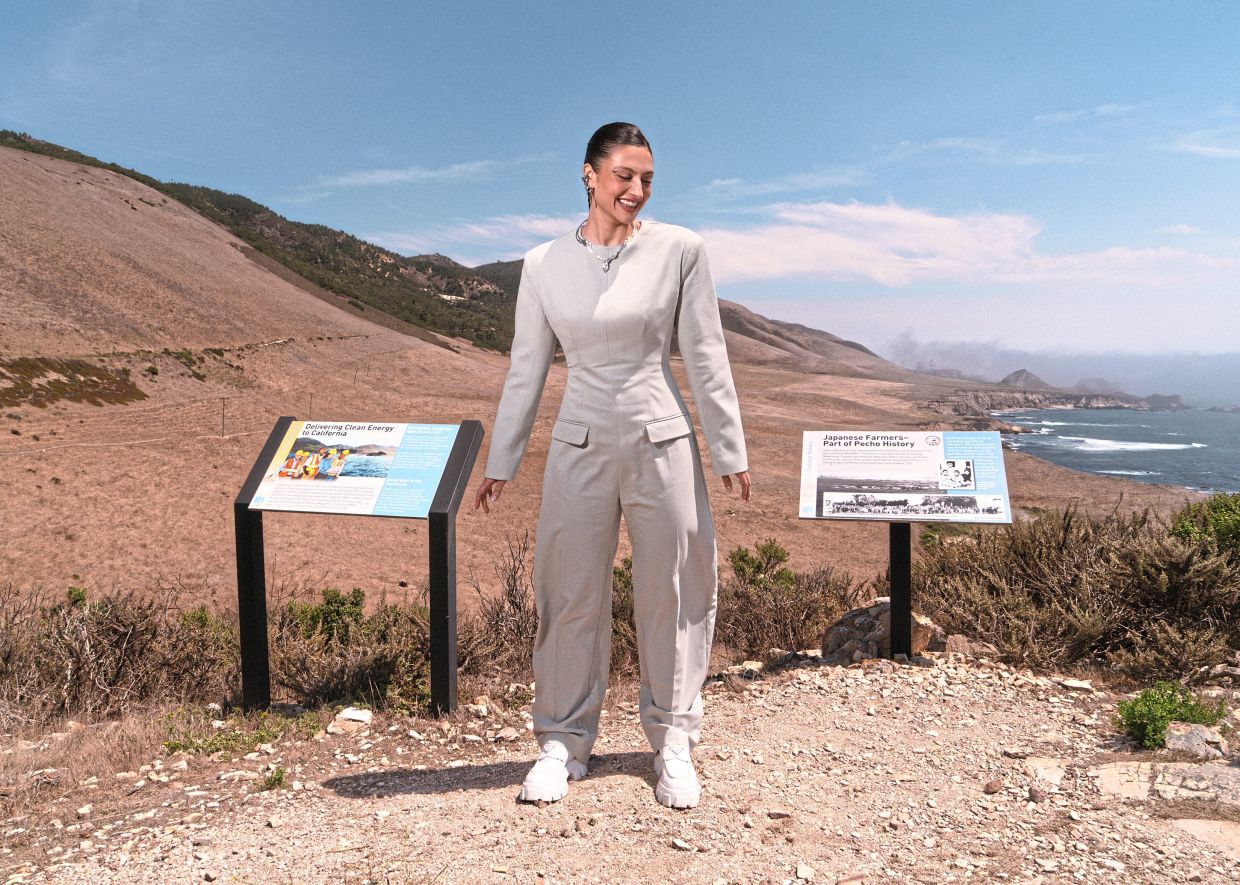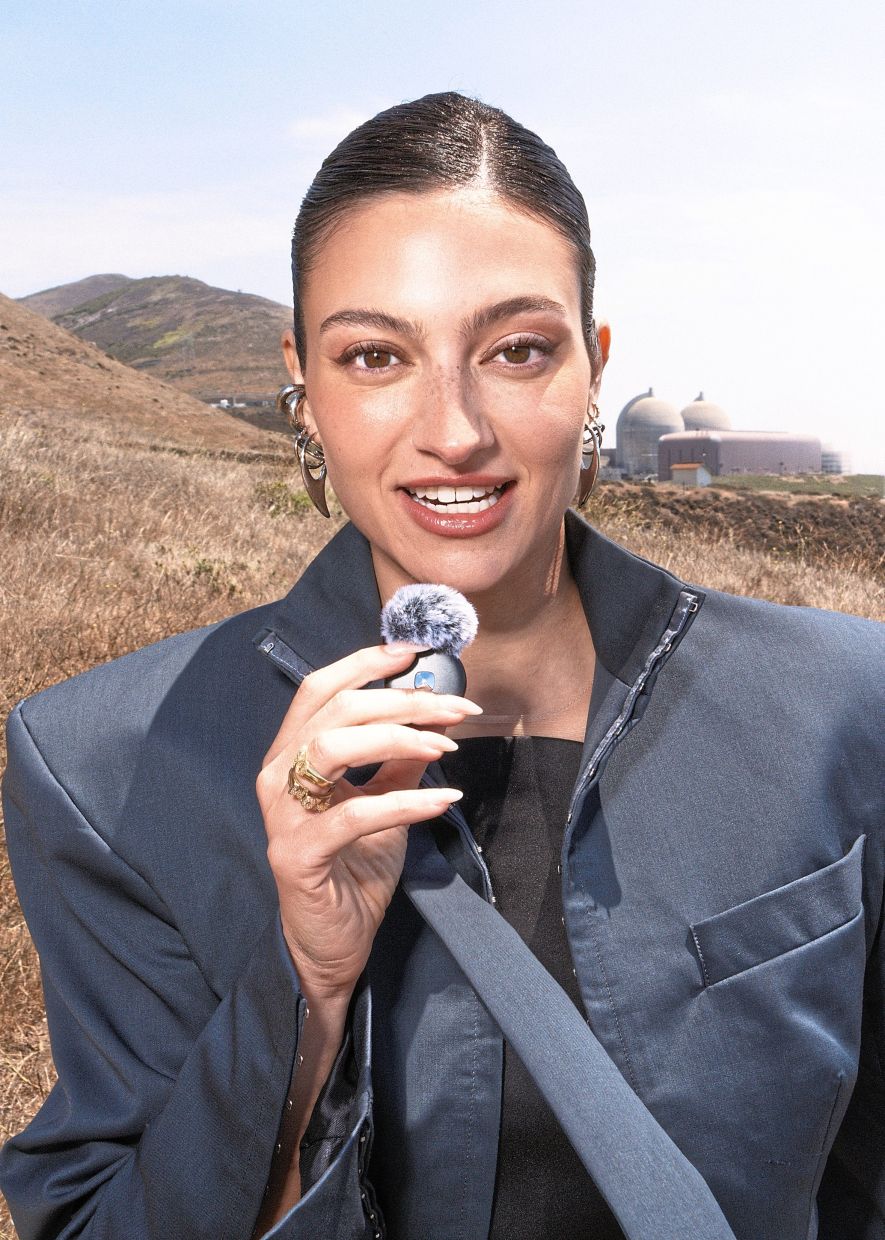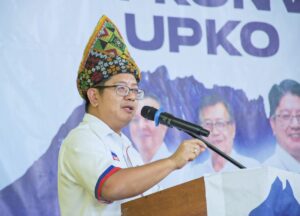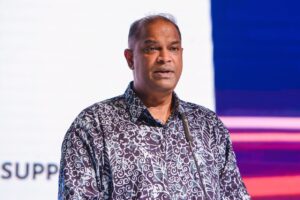“YOU have to go see the waste – did you see the waste?” Isabelle Boemeke shouted into the wind, which whipped her long, dark braid behind her as she stood on the California shoreline in San Luis Obispo.
The waste in question was the leftover uranium rods from producing nuclear energy, which are stored in thick casks of steel and concrete to keep them, at least theoretically, safely away from human beings.
Boemeke once kissed one of these casks.
In the distance behind her, occasionally visible behind the thick sea fog, was Diablo Canyon Power Plant, a nuclear power facility situated on a cartoonishly beautiful stretch of coastline.
Dressed in a blazer with sharp pointed shoulders and asymmetrical silver earrings, Boemeke looked like the hero of a dystopian novel set sometime in the future. (A future where Prada is still making loafers – more than slightly impractical for the rocky terrain.)
Several of the plant’s employees looked on, alert.
In 2020, Brazilian model Boemeke began posting on social media as Isodope, a persona she created for her nuclear advocacy work. On Isodope’s Instagram and TikTok pages, Boemeke uses familiar influencer tropes such as “get ready with me” videos, fitness regimens and beauty routines.
The point is to make nuclear energy appear cool while rendering high-level concepts digestible for a mainstream, very online audience. Boemeke has explained fusion and fission using Legos, and compared uranium pellets (which she also calls “magic spicy rocks”) to gummy bears, for scale.
The question is: why?
Boemeke says she has never taken money from the industry, though she has invested in Alva Energy, a startup that aims to “add six gigawatts of new nuclear capacity to the United States grid in under five years.
And last year, Boemeke donated US$5mil (RM21.1mil) and pledged an additional $5mil, to nuclear causes with her husband, Joe Gebbia, one of the most prominent members of the Trump administration’s Department of Government Efficiency and the billionaire co-founder of Airbnb. A friend and confidant of Elon Musk’s, Gebbia now sits on the board of Tesla. The couple lives in Austin, Texas, with their two-year-old son.
“We keep things very separate,” Boemeke said of her husband’s politics.
As Boemeke tells it, she was drawn to learning more about nuclear energy after experiencing climate anxiety in 2019, as wildfires ravaged the Amazon in her home country. She had been in the process of founding a cosmetics company, but said that the work didn’t feel “like my calling.”
Boemeke said the idea to become a nuclear influencer came to her while brushing her teeth during a 10-day water fast at a clinic in Spain, in a moment of hunger-induced clarity.
As bipartisan support for nuclear energy has gained momentum in recent years, both the Biden and the Trump administrations have outlined plans to expand nuclear energy in the US. And last year six more countries joined a growing pledge to triple the world’s use of nuclear power – once a taboo subject in climate talks – by 2050.
But the energy source continues to have many vocal opponents, including those with worries about safety. Some experts find Boemeke to be an ominous messenger for this cause – and the message itself to be dubious, too.
Edwin Lyman, director of nuclear power safety for the Union of Concerned Scientists, described Boemeke as “another cog in the whole wheel of the nuclear power influence machine that’s trying to change public opinion and the opinion of policymakers about nuclear power, its prospects, its safety in the intent to try to stimulate growth for the industry.”
In December 2021, Boemeke helped organise a rally to save the Diablo Canyon power plant, which its utility mother company had planned to shutter in 2025 to shift focus to renewable energy sources.
Linda Seeley, vice president of Mothers for Peace, a non-profit organisation that has protested against nuclear power for decades, said the group had filed lawsuits in an effort to close the plant.
“It’s beyond me how on earth some young people can take up this banner as their cause,” said Seeley, who lives in Los Osos, just up the coast from the plant. Do they understand what the consequence is having a nuclear reaction so close?
All of this may sound outlandish, but Boemeke has some influential figures in her corner.
Her book, Rad Future: The Untold Story of Nuclear Electricity and How It Will Save the World, came out recently with Thesis, an imprint of Penguin Publishing Group.
“I’m like a huge science nerd,” Boemeke said in an interview in a conference room at the nuclear plant, rattling off facts about the waste casks. Her publicist hovered nearby, silently overseeing the conversation.
Earlier, Boemeke had arrived at Diablo Canyon in a black Sprinter van accompanied by a small team, including her chief of staff, a makeup artist and a social media editor. Also in tow was Carolyn Porco, a planetary scientist and nuclear advocate whose posts online about nuclear energy caught Boemeke’s eye a decade ago. Over the past few years, they became friends. Porco, who lives near the power plant, was there to offer Boemeke “moral support,” Boemeke’s team said.
“There are those who say, ‘Oh, what would a model know about nuclear energy?’” Porco said. But Boemeke, she added, was “the real deal.”
Jacopo Buongiorno, a nuclear science and engineering professor at the Massachusetts Institute of Technology, said he had gotten to know Boemeke after meeting virtually during the pandemic.
Buongiorno, who is also the director of MIT’s Center for Advanced Nuclear Energy Systems, said in a phone interview that he was struck by her curiosity.
“Her style is great for her intended audience, and she does her homework,” he said.
But it’s not difficult to find others who are sceptical of Boemeke’s work.
“I just don’t see what she has to contribute to the argument,” said David Schlissel, co-founder of the Institute for Energy Economics and Financial Analysis, an energy research firm. Schlissel said other existing technology options, like battery storage and renewable energy, offered cheaper, faster solutions to reducing carbon emissions.
Leaving the conference room, Boemeke and her team hopped into their van and headed past the plant to the water’s edge to pose for pictures.
After Boemeke’s rally, California passed a law creating a pathway for the plant, California’s last operational nuclear outfit, to continue operating until 2030.
On the drive there, through layers of fences, one could indeed see the nuclear waste that got Boemeke so excited.
“It’s not a gag or a meme for the day,” said Seeley, the Mothers for Peace vice president.
“This is the future of the Earth we’re talking about.” — 2025 The New York Times Company







